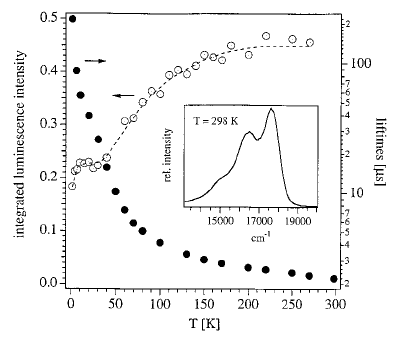
|
Photophysics and Photochemistry of Transition Metal Compounds |
| Home Research Members Collaborations Publications |

Stay informed of our last publications with our atom feed 
Author list
|
 |
|||||||
Luminescence and energy transfer in [Zn1-xRux(bpy)3][NaAl1-yCry(ox)3] (x ≈ 0.01, y = 0.006 − 0.22; bpy = 2,2‘-bipyridine, ox = C2O42-) and [Zn1-x-yRuxOsy(bpy)3][NaAl(ox)3] (x ≈ 0.01, y = 0.012) are presented and discussed. Surprisingly, the luminescence of the isolated luminophores [Ru(bpy)3]2+ and [Os(bpy)3]2+ in [Zn(bpy)3][NaAl(ox)3] is hardly quenched at room temperature. Steady-state luminescence spectra and decay curves show that energy transfer occurs between [Ru(bpy)3]2+ and [Cr(ox)3]3- and between [Ru(bpy)3]2+ and [Os(bpy)3]2+ in [Zn1-xRux(bpy)3][NaAl1-yCry(ox)3] and [Zn1-x-yRuxOsy(bpy)3] [NaAl(ox)3], respectively. For a quantitative investigation of the energy transfer, a shell type model is developed, using a Monte Carlo procedure and the structural parameters of the systems. A good description of the experimental data is obtained assuming electric dipole−electric dipole interaction between donors and acceptors, with a critical distance Rc for [Ru(bpy)3]2+ to [Cr(ox)3]3- energy transfer of 15 Å and for [Ru(bpy)3]2+ to [Os(bpy)3]2+ energy transfer of 33 Å. These values are in good agreement with those derived using the Förster−Dexter theory. | ||||||||
Download this list in format RIS
 EndNote
EndNote  BibTex
BibTex  PDF XML
PDF XML Last update Friday December 08 2017